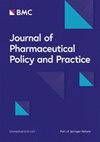A systematic review of the economic burden of diabetes mellitus: contrasting perspectives from high and low middle-income countries
IF 3.3
Q1 HEALTH POLICY & SERVICES
Journal of Pharmaceutical Policy and Practice
Pub Date : 2024-04-19
DOI:10.1080/20523211.2024.2322107
引用次数: 0
Abstract
ABSTRACT Introduction Diabetes increases preventative sickness and costs healthcare and productivity. Type 2 diabetes and macrovascular disease consequences cause most diabetes-related costs. Type 2 diabetes greatly costs healthcare institutions, reducing economic productivity and efficiency. This cost of illness (COI) analysis examines the direct and indirect costs of treating and managing type 1 and type 2 diabetes mellitus. Methodology According to the Preferred Reporting Items for Systematic Reviews and Meta-Analyses guidelines, Cochrane, PubMed, Embase, CINAHL, Scopus, Medline Plus, and CENTRAL were searched for relevant articles on type 1 and type 2 diabetes illness costs. The inquiry returned 873 2011–2023 academic articles. The study included 42 papers after an abstract evaluation of 547 papers. Results Most articles originated in Asia and Europe, primarily on type 2 diabetes. The annual cost per patient ranged from USD87 to USD9,581. Prevalence-based cost estimates ranged from less than USD470 to more than USD3475, whereas annual pharmaceutical prices ranged from USD40 to more than USD450, with insulin exhibiting the greatest disparity. Care for complications was generally costly, although costs varied significantly by country and problem type. Discussion This study revealed substantial heterogeneity in diabetes treatment costs; some could be reduced by improving data collection, analysis, and reporting procedures. Diabetes is an expensive disease to treat in low- and middle-income countries, and attaining Universal Health Coverage should be a priority for the global health community.糖尿病经济负担的系统性审查:高收入国家和中低收入国家的对比视角
ABSTRACT 引言 糖尿病会增加预防性疾病的发病率,并导致医疗保健和生产成本的增加。2 型糖尿病和大血管疾病的后果导致了大部分与糖尿病相关的费用。2 型糖尿病大大增加了医疗机构的成本,降低了经济生产力和效率。本疾病成本(COI)分析研究了治疗和管理 1 型和 2 型糖尿病的直接和间接成本。方法 根据《系统综述和元分析首选报告项目》指南,检索了 Cochrane、PubMed、Embase、CINAHL、Scopus、Medline Plus 和 CENTRAL 中有关 1 型和 2 型糖尿病疾病成本的相关文章。结果共检索到 873 篇 2011-2023 年的学术文章。在对 547 篇论文进行摘要评估后,本研究收录了 42 篇论文。结果 大多数文章来自亚洲和欧洲,主要涉及 2 型糖尿病。每位患者的年度成本从 87 美元到 9581 美元不等。基于患病率的成本估算从不到 470 美元到超过 3475 美元不等,而每年的药品价格从 40 美元到超过 450 美元不等,其中胰岛素的差异最大。并发症的治疗费用普遍较高,但不同国家和问题类型的费用差异很大。讨论 本研究揭示了糖尿病治疗费用的巨大差异;通过改进数据收集、分析和报告程序,可以减少其中一些差异。在中低收入国家,糖尿病是一种治疗费用昂贵的疾病,实现全民医保应成为全球卫生界的优先事项。
本文章由计算机程序翻译,如有差异,请以英文原文为准。
求助全文
约1分钟内获得全文
求助全文
来源期刊

Journal of Pharmaceutical Policy and Practice
Health Professions-Pharmacy
CiteScore
4.70
自引率
9.50%
发文量
81
审稿时长
14 weeks
 求助内容:
求助内容: 应助结果提醒方式:
应助结果提醒方式:


